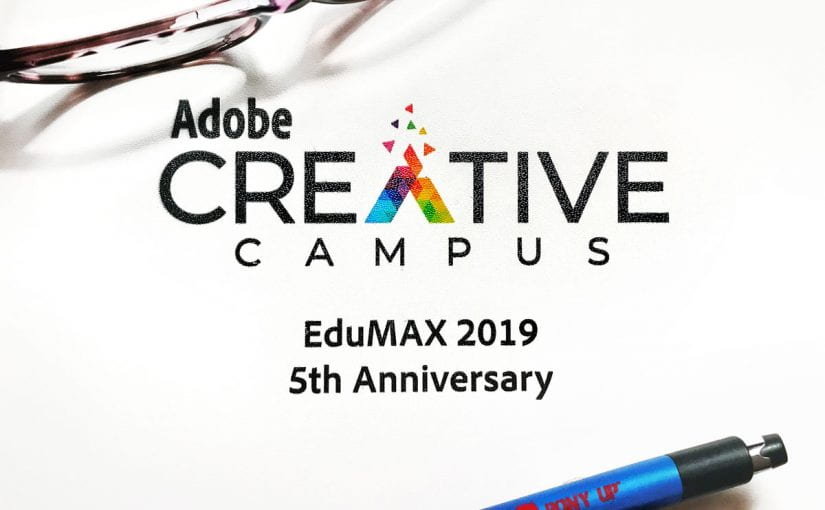
Last month, I had the opportunity to attend EduMAX, a pre-conference gathering of the Adobe Creative Campus Collaboration at Adobe MAX in Los Angeles. This year was the fifth anniversary of EduMAX. To celebrate, Adobe brought educational leaders and partners from across the globe to participate and discuss with other peer institutions how to enhance the student experience with Adobe tools. Eight schools were represented by over 20 different speakers covering social justice, becoming a Creative Campus, improving digital literacy, and even spotlighting the achievements of students.
To kick off the event, Bryan Lamkin, the executive vice president and general manager of digital media at Adobe, discussed Adobe’s continued dedication to education through the Adobe Creative Campus program and digital literacy. “We define digital literacy as the power to use digital tools to solve problems, produce innovative projects, enhance communication, and prepare for the challenges of an increasingly digital world.” The Adobe Creative Campus assists in that mission by providing the Adobe Creative Cloud suite of tools to be accessed outside of the classroom and labs by the entire student body and across all disciplines. “The workplace [in the future] will look quite different.” Lampkin continued, “We are in an AI revolution.” Adobe sees student creative thinking and skill as an asset in this new workforce. Adobe has also put together a Cultivating Digital Literacy to spotlight how colleges and universities can teach digital literacy and these essential soft skills in this new age of automation and digital transformation.

Sid Dobrin, Professor and Chair of the English Department at the University of Florida, followed up that call for digital literacy. “There is a need for digital storytellers… Every tech company needs English majors.” Dobrin did point out that we cannot assume that the “if we build it, they will come” model will work. For a successful implementation, a university needs to commit by providing the training and motivation for all areas to embrace digital literacy. Related to this, Dr. Todd Taylor, Professor of English at the University of North Carolina Chapel Hill, has authored Adobe Creative Cloud Across the Curriculum. This free, online e-textbook is becoming the definitive guide for using Adobe Creative Cloud across the curriculum.
Jean Cheng, Program Manager of the Academic Innovation Studio, and Victoria Robinson, Director of American Cultures Center at UC Berkley, along with Pablo Gonzalez, Continuing Lecturer in Chicana/o Studies and Ethnic Studies and Susan Schweik, Professor of English, had an open panel discussion on “Fostering Agency in the context of creativity and social justice.” The panel discussed how they wanted to bring lived experiences into the learning environment in a holistic way. They were able to bring the Adobe tools into the academic experience and support the faculty’s area of interest. These tools, such as using Adobe Spark, would allow students to have a connection with the course content and create work that can “walk in the world,” Gonzalez shared. “The ability to tell stories is a brave act,” and these tools allowed their students to do that. Professor Schweik also shared, as a bonus, that “It is so much more exciting to read a Spark page versus a paper.” To foster all of this, UC Berkley provides training and support to its faculty through the Academic Innovation Studio and Digital Learning Innovation grants to motivate faculty engagement.
The Student Spotlights were a true highlight of EduMAX. Valentina Arismendi, a Media and Journalism Major and Digital Literacy Minor at the University of North Carolina at Chapel Hill discussed how she used the Adobe Creative Cloud to further her education with her fellow students. “Everyone picked up the tools quite quickly.” She was even able to use Adobe UX to build and prototype a mobile app without being a developer.

Massachusetts Institute of Technology (MIT) student, Hillary Diane Andales was also on hand to discuss her experiences. Hillary first started using Adobe Photoshop in grade school while living in the Philippines. Using her skills, she started creating logos for her school, then flyers. As her skills progressed into other applications in the Adobe Creative Cloud, she then created camps for younger students in the area and even wrote a book, Math Quizzer. She then started using Adobe Premiere to produce educational videos to demonstrate complex ideas. Her video explaining relativity using a pickup truck and Usain Bolt went viral and ended up winning $250,00 in the Breakthrough Junior Challenge. All this has helped her to reach her dreams, including attending MIT. She is currently majoring in Physics with a minor in Astronomy and Philosophy/STS and is planning on graduating in 2023.
While SMU is not currently an Adobe Creative Campus, that doesn’t stop us from being able to implement the Adobe Creative Cloud applications into our instruction or help develop a student’s digital literacy. In my Sparking Your Social Media class, I demonstrate how easy it is for students to tell their stories and share their experiences, from such events as Alternative Spring Breaks or the Civil Rights Pilgrimage, using Adobe Spark. There are other great opportunities in other areas; We just have to seek them out. If you have any questions about using Adobe Creative Cloud in your courses, please contact your local ATSD or the IT Help Desk.
You can review official Adobe EDUMAX Full Event Recap at https://spark.adobe.com/page/R0Clw1p9HNXAN/



